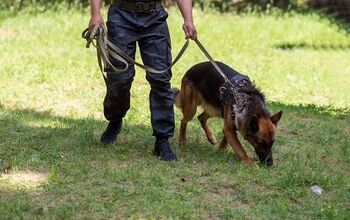Reverse Zoonosis: Can You Make Your Dog Sick?

You may have heard the saying that nothing is cleaner than a dog’s mouth. While this may not be strictly true, there is a low risk for your dog transmitting some kind of disease to you. The question that researchers have recently begun to ask, however, is whether humans can pass disease to animals – this is called reverse zoonosis. Keep reading to learn more.
What is Reverse Zoonosis?
The word zoonosis comes from the Greek word for animal, zoon, and it refers to infectious diseases of animals that can be transmitted naturally to humans. Some examples of diseases that can be passed from animal to humans include salmonella and Ebola.
Related: Leptospirosis in Dogs: What Every Dog Owner Needs to Know
During the early 20th century, HIV was also a zoonotic disease, though it has since evolved into a disease that only affects humans. There are several different methods of transmission for zoonoses, though the main two are direct zoonosis and reverse zoonosis. Direct zoonosis occurs when a disease is transmitted directly from an animal to a human, usually through the air or the saliva. Reverse zoonosis is when a human infects an animal – this is also known as anthroponosis.
Which Diseases Can Be Passed from Humans to Animals?
Reverse zoonosis has become something of a global issue recently, particularly involving animals bred for food. These animals are transported all over the world and they have the potential to interact with wild species that they might not otherwise have encountered.
Related: Deadly Dog Disease ‘Alabama Rot’ Afflicting Pets in the UK
An example of this in real life is the H1H2 influenza pandemic of 2009. Pigs bred for food were transported long distances, thousands of miles, over a 24-hour period which allowed the disease to spread across the world in a matter of a few months. Many countries have restrictions in place regarding the movement of animals, but there are still diseases which are being transmitted from humans to animals. Here are a few examples:
- A 2006 study published in the journal Veterinary Microbiology explored the spread of MRSA from people to pets with several cases of the infection being spread from a human to a dog and then back to the human again after treatment resolved the initial infection.
- In 2004, there was a case of a Yorkshire Terrier becoming infected with tuberculosis – once the dog was diagnosed it was revealed that the owner had been in treatment for TB for 6 months.
- In 2009, the first recorded case of human-to-cat transmission of the H1N1 virus occurred in Oregon, claiming the life of the cat.
- In 2010, a study was published regarding Giardia duodenalis infections in African wild dogs – the particular strain of the parasite is one typically associated with humans rather than pets.
Though there is the potential for humans to transmit certain diseases to animals, it is not something you need to be overly concerned about. Your dog has a strong immune system that protect him from pathogens and your risk for carrying a disease that can be transmitted to animals is low. Even so, it is a good idea to follow basic hygiene practices to keep both you and your dog safe.

Kate Barrington is the loving owner of two cats (Bagel and Munchkin) and a noisy herd of guinea pigs. Having grown up with golden retrievers, Kate has a great deal of experience with dogs but labels herself a lover of all pets. Having received a Bachelor's degree in English, Kate has combined her love for pets and her passion for writing to create her own freelance writing business, specializing in the pet niche.
More by Kate Barrington























